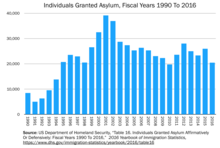| United States citizenship and immigration |
|---|
| Immigration |
| Citizenship |
| Agencies |
| Legislation |
| History |
| Relevant legislation |
|
|


The United States recognizes the right of asylum for individuals seeking protections from persecution, as specified by international and federal law. People who seek protection while outside the U.S. are termed refugees, while people who seek protection from inside the U.S. are termed asylum seekers. Those who are granted asylum are termed asylees.
A specified number of legally defined refugees who are granted refugee status outside the United States are annually admitted under 8 U.S.C. § 1157 for firm resettlement.[1][2] Other people enter the United States with or without inspection, and apply for asylum under section 1158.[3]
Asylum in the United States has two specific requirements. First, asylum applicants must be physically present in the United States, or at a designated port of arrival.[4] Second, they must show that they suffered persecution in the past, or have a well-founded fear of future persecution in their country of nationality and permanent residency[5] on account of at least one of the five protected grounds: race, religion, nationality, political opinion, or membership in a particular social group.[3][6]
Even if an individual meets the criteria for asylum, INA § 208, bars some asylum seekers from asylum. These restrictions fall into two categories: (1) limitations on the ability to apply for asylum and (2) limitations on the ability to be granted asylum.[7][8]
The majority of asylum claims in the United States fail or are rejected.[9] While asylum denial rates had grown to a peak of 71 percent in FY 2020, they fell to 63 percent in FY 2021.[10] One third of asylum seekers go to courts unrepresented although those with legal representation have higher chances of winning.[11]
More than three million refugees from various countries around the world have been admitted to the United States since 1980.[12][2] In recent years, the number of refugees admitted by the U.S. has fluctuated due to changes in government policies. For example, the U.S. resettled 84,995 refugees in the fiscal year 2016.[13] The number of refugees admitted declined significantly, with only 11,814 admitted in the fiscal year 2020.[14] The Biden administration aims to increase the number of refugees accepted by setting higher caps for admissions.[15] In 2024 the Biden Administration maintained the 125,000 person cap on refugee admissions.[16]
- ^ Cite error: The named reference
Reznikwas invoked but never defined (see the help page). - ^ a b Cite error: The named reference
lawful entrywas invoked but never defined (see the help page). - ^ a b Cite error: The named reference
asylumwas invoked but never defined (see the help page). - ^ "Asylum | USCIS". www.uscis.gov. 2022-11-09. Retrieved 2023-04-21.
- ^ Rempell, Scott (2011-10-08). "Defining Persecution". Rochester, NY. SSRN 1941006.
{{cite journal}}: Cite journal requires|journal=(help) - ^ Cite error: The named reference
A-B-was invoked but never defined (see the help page). - ^ "8 USC 1158: Asylum". uscode.house.gov. Retrieved 2023-04-21.
- ^ Smith, Hillel (September 7, 2022). "An Overview of the Statutory Bars to Asylum: Limitations on Applying for Asylum" (PDF). Congressional Research Service Legal Sidebar – via CSR Legal Sidebar.
- ^ "Refugees in the United States of America". Worlddata.info. Retrieved 2023-04-21.
- ^ "Asylum Grant Rates Climb Under Biden". trac.syr.edu. Retrieved 2023-04-21.
- ^ Rabben, Linda 1947- Verfasser. (2016). Sanctuary and asylum : a social and political history. University of Washington Press. ISBN 978-0-295-99912-8. OCLC 964063441.
{{cite book}}:|last=has generic name (help)CS1 maint: numeric names: authors list (link) - ^ "U.S. Refugee Admissions Program". United States Department of State. Retrieved 2021-12-05.
- ^ "Fact Sheet: Fiscal Year 2016 Refugee Admissions". Fact Sheet: Fiscal Year 2016 Refugee Admissions. U.S. Department of State, Secretary for Public Diplomacy and Public Affairs. Retrieved April 21, 2023.
- ^ "An Overview of U.S. Refugee Law and Policy". American Immigration Council. 2015-11-18. Retrieved 2023-04-21.
- ^ "Statement by President Joe Biden on Refugee Admissions". The White House. 2021-05-03. Retrieved 2023-04-21.
- ^ "Biden administration plans to keep refugee cap at 125,000". CNN. September 26, 2023.
